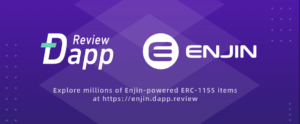Witek Radomski is co-founder and CTO of the ever-evolving Enjin ecosystem. Back in 2018, he was the author and force behind the standard for ERC-1155 multi-tokens and NFTs.
ERC-20, ERC-721, and ERC-1155 are the three major protocols or token standards. Cryptocurrency tokens built on Ethereum (like Enjin Coin) follow the ERC-20 standard. The ERC-721 and ERC-1155 standards are used by NFTs. While ERC-721 is a legacy standard made for one-off NFTs, ERC-1155 takes things a lot further and will be explained more in the article.
Token standards are a set of rules that govern the creation of smart contracts for cryptocurrency and NFTs, thus allowing them to be used in a variety of wallets, marketplaces, and other apps.

From gaming to sports, art, entertainment and beyond
Enjin’s COO Caleb Applegate joined co-CTOs Witek Radomski and Lukasz Orlowski to share insights regarding the interoperable, cross-chain Paratoken Standard being developed alongside Efinity.
Before jumping in, Enjin’s COO liked to kick things off by thanking all of you for your incredible support during the launch of the Efinity Token (EFI) earlier this month!
If you’d like to learn more about the projects Enjin is developing and the features they are prioritizing, tune in for our bi-weekly vlogs and recaps.
To learn more about Paratokens—what they are, and why they’re important for Efinity—read on.
What is a token standard?
Our Co-founder & CTO Witek Radomski is the force behind the ERC-1155 token standard, having created it back in 2018.
ERC-1155 is a token standard for Ethereum. So… what does that mean?
Let’s say you want to create something on Ethereum, whether a new cryptocurrency or an NFT. You’d probably want apps, wallets, and smart contracts to recognize your tokens, right?
That’s what token standards are for; they’re basically a set of rules for creating smart contracts that power cryptocurrencies and NFTs, so that they can be used in as many wallets, marketplaces, and other apps as possible.
Cryptocurrency tokens built on Ethereum (like Enjin Coin) follow the ERC-20 standard. On the other hand, NFTs use the ERC-721 and ERC-1155 standards. While ERC-721 is a legacy standard made for one-off NFTs, ERC-1155 takes things a lot further.
For example, with ERC-1155, you can group NFTs and fungible tokens in the same contract, creating different types of tokens and adding functionality around them.
Some of the cool features of ERC-1155 are not only cheaper transactions (saving up to 90% on gas fees when minting!), but any block explorer gets a ton of info about what exactly happened with your tokens, whether they were minted, burned, or anything else.
Not too shabby, right?
Next-Gen NFTs: The Paratoken Standard
As Enjin develops Efinity on Polkadot, our team is working on a brand new standard that is going to be a pretty big deal for the NFT community: the Paratoken Standard.
Built for Polkadot, the goal of the Paratoken Standard is to make tokens interoperable—in the entire Polkadot-Substrate-Kusama ecosystem, as well as for all the Polkadot parachains being built, and other blockchains.
In other words, they want to enable everyone to bring tokens in from other chains like Ethereum, and have them expressed as a paratoken on a parachain like Efinity.
As the Paratoken Standard nears completion, they want to get feedback from teams and projects in the ecosystem. In the coming weeks, Enjin be releasing the standard open-source onto the Substrate Open Working Groups GitHub. they will then revise and improve the standard before posting it to the community for feedback, and get the general public’s feedback before it’s finalized.
If this sounds like complex technobabble, don’t worry—they will break down the details in a short and sweet list below.
1. Token ID
The ID of your token will contain info about where it’s from and where it was minted, ushering in a super-efficient tokenization system. Anyone will be able to tell exactly which blockchain network your tokens are from.
Today, if you try doing this with the ERC-721 standard, there’s a lot of difficulties in efficiency, since every smart contract is implemented differently. Consequently, there’s no way you can trust it since you don’t know if the smart contract is 100% reliable.
Because of that, every token contract on Ethereum has to be overly suspicious, and by being so, it costs a lot to operate.

2. Native Tokens
The native tokens Enjin is building has predictable functionality. In support of this, they are introducing something called monetary policies, so if you own a token, you know exactly how that token will behave based on its policy.
A policy could include a token’s total supply, for example, which could tell whether there are any tokens left that can be minted.

3. Extensions
Yet another feature of paratokens is known as extensions. This is a powerful way for anyone building on Polkadot to extend the functionality of tokens while building innovative practicality into them.
One of these extensions, batch transfers, lets you send millions of tokens at once. There’s also chunking, which basically allows you to send a range of them whether or not they fit into one block.

4. Connecting the Dots
Keeping in mind all of the awesome functions mentioned above, the final step is in connecting with different parachains, and with the entire ecosystem on Polkadot and Kusama. By communicating with them, our goal of standardizing tokens becomes reality.
In fact, that’s the whole point of the Paratoken Standard: Enjin wants everyone to be able to easily send things in between parachains and different blockchains.

Summary for Q3 and Q4
Enjin has a busy remainder for Q3, and will be taking Q4 by storm as they unleash some of the most advanced products Enjin has ever developed.
Stay tuned for Episode 3 next week, as they have some amazing things to brief you on.
Find Original Published Article HERE

